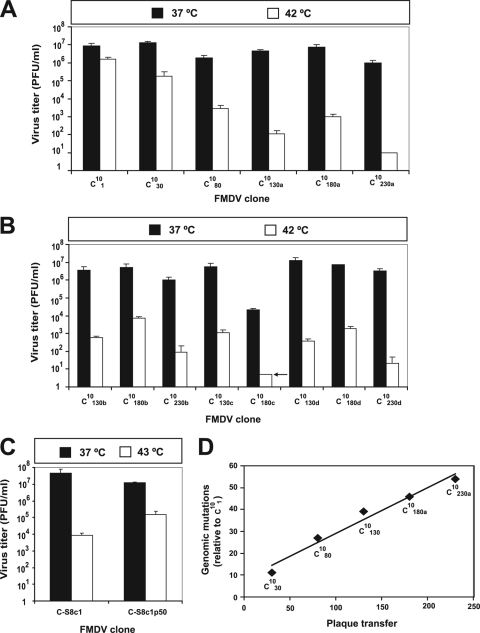FIG. 2.
Thermosensitivity and accumulation of mutations upon subjecting FMDV clone C101 to plaque-to-plaque transfers. The origin of C101 and the experimental design are described in Fig. 1. (A) Progeny production at 37°C and 42°C in parallel infections of 2 × 106 BHK-21 cells, with the clones indicated in the abscissa, at MOIs of 0.1 to 0.01 PFU/cell. After 1 h of adsorption at 37°C, the monolayers were incubated at 37°C or at 42°C for 22 h to 44 h until cytopathology at 37°C was complete. Titers in the cell culture supernatants were determined at 37°C in triplicate; standard deviations are given. (B) Progeny production at 37°C and 42°C of virus from C10180 and C10230 for sublineages b, c, and d (compare Fig. 1). Virus from sublineage c at transfer 180 yielded an undetectable number of plaques at 42°C (below the limit of detection, as indicated by the arrow); virus from this sublineage became noncytophatic at plaque transfer 190 (20), and therefore thermosensitivity at transfer 230 could not be measured. Titrations for the three lineages were carried out in separate experiments, but for each lineage the titrations of plaques in C10180 and C10230 were carried out in parallel, and C10130 (the parental clone of sublineages a, b, c, and d) (Fig. 1) was included as a control. The procedure is as described for panel A. (C) Progeny production at 37°C and 43°C of C-S8c1 and C-S8c1 subjected to 50 serial passages in BHK-21 cells (MOI of 1 to 2 PFU/cell) at 37°C. Note that in this control the restrictive temperature was 43°C and that the thermosensitivity of C-S8c1 need not be identical to that of C101 due to passage history (Fig. 1) and to FMDV population heterogeneity. (D) Accumulation of mutations, relative to the genomic sequence of C101, as a function of the plaque transfer number. Values are based on the nucleotide sequence of the entire FMDV genome, as previously described (23). Procedures are described in Materials and Methods.

